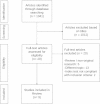Glucose prediction by analysis of exhaled metabolites - a systematic review
- PMID: 24963286
- PMCID: PMC4068184
- DOI: 10.1186/1471-2253-14-46
Glucose prediction by analysis of exhaled metabolites - a systematic review
Abstract
Background: In critically ill patients, glucose control with insulin mandates time- and blood-consuming glucose monitoring. Blood glucose level fluctuations are accompanied by metabolomic changes that alter the composition of volatile organic compounds (VOC), which are detectable in exhaled breath. This review systematically summarizes the available data on the ability of changes in VOC composition to predict blood glucose levels and changes in blood glucose levels.
Methods: A systematic search was performed in PubMed. Studies were included when an association between blood glucose levels and VOCs in exhaled air was investigated, using a technique that allows for separation, quantification and identification of individual VOCs. Only studies on humans were included.
Results: Nine studies were included out of 1041 identified in the search. Authors of seven studies observed a significant correlation between blood glucose levels and selected VOCs in exhaled air. Authors of two studies did not observe a strong correlation. Blood glucose levels were associated with the following VOCs: ketone bodies (e.g., acetone), VOCs produced by gut flora (e.g., ethanol, methanol, and propane), exogenous compounds (e.g., ethyl benzene, o-xylene, and m/p-xylene) and markers of oxidative stress (e.g., methyl nitrate, 2-pentyl nitrate, and CO).
Conclusion: There is a relation between blood glucose levels and VOC composition in exhaled air. These results warrant clinical validation of exhaled breath analysis to monitor blood glucose levels.
Keywords: Breath; Glucose; Monitoring; Volatile organic compound.
Similar articles
-
The oral microbiome and its effect on exhaled breath volatile analysis-the elephant in the room.J Breath Res. 2025 Aug 11;19(4). doi: 10.1088/1752-7163/adf505. J Breath Res. 2025. PMID: 40720974
-
Clinical use of exhaled volatile organic compounds in pulmonary diseases: a systematic review.Respir Res. 2012 Dec 21;13(1):117. doi: 10.1186/1465-9921-13-117. Respir Res. 2012. PMID: 23259710 Free PMC article.
-
[The influence of dietary pattern on the production of volatile organic compounds in patients with hydrogen-producing small intestinal bacterial overgrowth syndrome].Vopr Pitan. 2025;94(2):106-116. doi: 10.33029/0042-8833-2025-94-2-106-116. Epub 2025 Mar 17. Vopr Pitan. 2025. PMID: 40418139 Russian.
-
Development of a Predictive Model for Colorectal Cancer Using Exhaled Volatile Organic Compounds.Dis Colon Rectum. 2025 Jun 1;68(6):736-745. doi: 10.1097/DCR.0000000000003706. Epub 2025 Mar 5. Dis Colon Rectum. 2025. PMID: 40044408
-
Hybrid closed-loop systems for managing blood glucose levels in type 1 diabetes: a systematic review and economic modelling.Health Technol Assess. 2024 Dec;28(80):1-190. doi: 10.3310/JYPL3536. Health Technol Assess. 2024. PMID: 39673446 Free PMC article.
Cited by
-
Significance of Exhaled Breath Test in Clinical Diagnosis: A Special Focus on the Detection of Diabetes Mellitus.J Med Biol Eng. 2016;36(5):605-624. doi: 10.1007/s40846-016-0164-6. Epub 2016 Oct 11. J Med Biol Eng. 2016. PMID: 27853412 Free PMC article. Review.
-
Low-Cost ZnO Spray-Coated Optical Fiber Sensor for Detecting VOC Biomarkers of Diabetes.Sensors (Basel). 2023 Sep 15;23(18):7916. doi: 10.3390/s23187916. Sensors (Basel). 2023. PMID: 37765971 Free PMC article.
-
Quantification of Volatile Acetone Oligomers Using Ion-Mobility Spectrometry.J Anal Methods Chem. 2021 Aug 2;2021:6638036. doi: 10.1155/2021/6638036. eCollection 2021. J Anal Methods Chem. 2021. PMID: 34395017 Free PMC article.
-
Innovations in Cattle Farming: Application of Innovative Technologies and Sensors in the Diagnosis of Diseases.Animals (Basel). 2023 Feb 21;13(5):780. doi: 10.3390/ani13050780. Animals (Basel). 2023. PMID: 36899637 Free PMC article. Review.
-
Exhaled Breath Analysis for Diabetes Diagnosis and Monitoring: Relevance, Challenges and Possibilities.Biosensors (Basel). 2021 Nov 25;11(12):476. doi: 10.3390/bios11120476. Biosensors (Basel). 2021. PMID: 34940233 Free PMC article. Review.
References
-
- Finfer S, Wernerman J, Preiser J-C, Cass T, Desaive T, Hovorka R, Joseph JI, Kosiborod M, Krinsley J, Mackenzie I, Mesotten D, Schultz MJ, Scott MG, Slingerland R, Van den Berghe G, Van Herpe T. Clinical review: consensus recommendations on measurement of blood glucose and reporting glycemic control in critically ill adults. Crit Care. 2013;17:229. - PMC - PubMed
-
- Aragon D. Evaluation of nursing work effort and perceptions about blood glucose testing in tight glycemic control. Am J Crit Care. 2006;15:370–377. - PubMed
-
- Karon BS, Boyd JC, Klee GG. Glucose meter performance criteria for tight glycemic control estimated by simulation modeling. Clin Chem. 2010;56:1091–1097. - PubMed
Publication types
MeSH terms
Substances
LinkOut - more resources
Full Text Sources
Other Literature Sources
Medical


